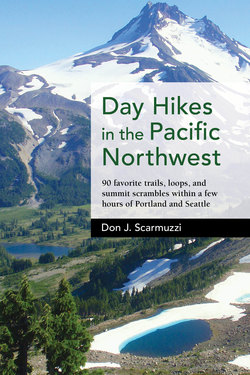Читать книгу Day Hikes in the Pacific Northwest - Don J. Scarmuzzi - Страница 16
Оглавление| 10 | COLDWATER PEAK |
ELEVATION: 5727 ft, with about 2000 ft vertical gain
DISTANCE: 6 mi one way, 12 mi round-trip
DURATION: 3–4 hours up, 6–8 hours round-trip
DIFFICULTY: Strenuous. Long, some steeps but not bad, rocky, drop-offs, narrow
TRIP REPORT: Fairly easy access to the goods for hiking within the Mount St. Helens volcanic blast zone is located at the Johnston Ridge Observatory (milepost 52 on State Road 504). David Johnston, who was the unfortunate volcanologist stationed N of the volcano that fateful day in May, was supposed to be out of harm’s way when in fact the opposite was true. The summer crowds thin to the fork for Harry’s Ridge, where even fewer hikers continue to Coldwater Peak or beyond. Bring plenty of water as the trails are dry. There are few services at the interesting interpretive center and little to no food options as is the case with all of the official viewpoints surrounding the mountain, which never received National Park status and kept the region rather wild without much infrastructure. A Monument Pass (day use fee per person over sixteen) is required for any of the viewpoints or trails from the observatory (open mid-May through October, 10 a.m.–6 p.m., restrooms inside), which is only 5 mi N of the crater in the center of the blast zone. You can always pay after if you get an early start hiking. The very best and free exhibits to be found for the volcano are at the Science and Learning Center back near milepost 43.
TRAILHEAD: Johnston Ridge Observatory. Take I-5 N from Portland and I-5 S from Seattle to exit 49 (Castle Rock/Toutle), turn toward Mount St. Helens Visitor Center on WA-504 E 50 mi to the end at a very large parking lot (110 mi, 2 hours from Portland; 155 mi, 3 hours from Seattle).
Spirit Lake and Mount St. Helens command your attention on the wildflower-covered trail near the summit of Coldwater Peak.
ROUTE: Begin up and over the hill on the trail past the first major viewpoint from the observatory, or better yet start the long hike from the far NE corner of the parking lot near another kiosk on the easier, paved Boundary Trail 1. The trail turns to dirt after the spur to the right (which leads up to the viewpoint and observatory). Follow great signage the entire way as Mount St. Helens is definitely the focus and there will be plenty of other eye candy to distract you as well. Bright red paintbrush and other wildflowers (late June into July) blanket the foreground as you work SE down and up the wide path past some scattered low flora.
Stay on the main trail as it narrows and requires your attention around a point to the junction with Truman Trail 207 (to Windy Ridge) at less than 2½ mi from the TH. Continue left (NE) up Boundary Trail 1 without difficulty less than a mile above the valley (possible elk or deer sightings) to the saddle and intersection with Harry’s Ridge Trail 208, which heads to the right a mile to one of the better views above Spirit Lake. Hike left (N) instead from the wide saddle up the pumice path as the wind begins to pick up. See the sizable Spirit Lake coming into view with Mount Adams behind. Move up 2 switchbacks, then steeper and narrower on a steady traverse around left. After the third switchback, see Mount Hood above Harry’s Ridge left of Mount St. Helens. After the seventh switchback, cross to the E side of the ridge passing old tree trunk bottoms with the tops completely missing or in the lakes. Soon you’ll see St. Helens Lake (also partially covered with old trees floating since May 18, 1980), the top of Mount Rainier, and Coldwater Peak!
The famous eruption’s landslide completely displaced all of the water from Spirit Lake in the form of a 600-ft wave that crashed onto the hillsides N, tearing all of the trees down then pulling them back into the lakes (including nearby Coldwater Lake) along with hundreds of feet of debris. This raised the water level 200 ft at Spirit Lake and created St. Helens Lake. Trees farther back were incinerated from the pyroclastic flow that followed.
Come down a fairly steep and slick switchback immediately and carefully to Hole-in-the-Wall Arch. Walk through the rocky doorway (with the only guaranteed shade of the day) to some of the best views on the hike! This arch and Coldwater Peak are both clearly visible from the TH area. Remain on the narrow, wildflower-surrounded trail down another steep switchback to better footing near another saddle and junction at 5 mi from the TH. Continue to the right on Trail 1 (opposite Coldwater Trail 230 heading NW) on an easier traverse above St. Helens Lake ½ mi N to the junction and signage for the summit to the left on Trail 1E.
Finish steadily on Trail 1E WSW up 13 switchbacks (only slightly overgrown at times) to the very top over the boulders near the last little old tower. If you frame Mount St. Helens correctly you can even hide the other seismic monitors on the summit area, which is covered with Western pasqueflower and others. See more of Goat Rocks to Mount Adams, Mount Rainier, and Mount Hood, with the continuation of the ridge leading to The Dome, Mount Margaret, and Mount Whittier. Return by the same route.
Trail to Coldwater Peak on the left under St. Helens Lake with the top of Mount Rainier barely discernible.
